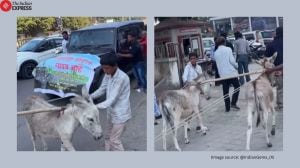As TN BJP chief calls Jayalalithaa a ‘Hindutva’ leader, why AIADMK says there is a difference
A close Jayalalithaa aide said she had even asked BJP in 1998 to prioritise eradication of poverty and unemployment over issues like Ayodhya, Kashi and Mathura temples
 Tamil Nadu BJP President K Annamalai; Former Tamil Nadu chief Minister Jayalalithaa
Tamil Nadu BJP President K Annamalai; Former Tamil Nadu chief Minister JayalalithaaTamil Nadu BJP president K Annamalai’s recent statement calling AIADMK icon and ex-chief minister late Jayalalithaa a “Hindutva leader” has been sharply contested by the AIADMK camp and her associates.
Hitting back at Annamalai, they have sought to make a distinction between Jayalalithaa’s personal Hindu faith and the Hindutva ideology.
Jayalalithaa’s close aide V K Sasikala was the first to react to Annamalai’s comments. “Amma (as Jayalalithaa was called by her followers) had faith in God, but not in religion. She was the only unparalleled leader who treated everyone equally throughout her life… No one can confine such a distinguished leader to any narrow bounds,” Sasikala said. “Amma transcended caste, religion, and divisions, and was revered and admired by people from all walks of life throughout her life.”
Senior AIADMK leader D Jayakumar also criticised Annamalai and condemned his statement “for defaming Amma by portraying her as a sectarian leader”. Asserting that Jayalalithaa was a leader who transcended caste and religious differences to become a leader for all, Jayakumar said she “treated all religions equally”.
Jayalalithaa’s faith and practices have often been scrutinised. As a believer in Hinduism, she too followed the practices of the faith, which differ vastly from place to place. However, what triggered the controversy was her faith being equated with Hindutva, as a slew of AIADMK leaders, Jayalalithaa’s aides and observers felt this was a “misrepresentation”.
Those who were associated with Jayalalithaa for a long time clarified that she was a believer in Hinduism in the same way as millions of others — as a private practice.
Jayalalithaa’s tenure as the CM saw several moves that was seen to be in alignment with pro-Hindu sentiments. However, she also came in line of fire during her first stint as the CM between 1991 and 1996, when the Kumbakonam incident occurred in 1992, in which 48 devotees died in a stampede at a temple event in which Jayalalithaa and Sasikala were present.
During this term, she also held the Hindu Religious and Charitable Endowments portfolio.
In Jayalalithaa’s next term as the CM, the AIADMK government passed the Tamil Nadu Prohibition of Forcible Conversion of Religion Act, 2002, and attempted to enforce a ban on animal sacrifice in temples, though these measures were later abandoned due to severe opposition. But these acts were seen more as “exceptions” influenced by a Brahmin lobby in her otherwise inclusive and secular governance. Her government also focused on the ‘annadhanam’ scheme, meant for feeding the poor in temples.
And yet, Jayalalithaa had no doubt that the biggest issue in India is not building temples but poverty, said one of her close aides, who was associated with her from the 1990s until her death, adding that she had even asked the BJP in 1998 to prioritise eradication of poverty and unemployment over issues like the Ayodhya, Kashi and Mathura temples.
The aide, on condition of anonymity, maintained that “Jayalalithaa’s faith was personal”. “She was never attached to the RSS. She maintained a clear separation from the RSS ideology and upheld a secular approach. She respected and honoured all religions throughout her life. She had no reservations regarding Christians or Muslims, nor any sense of ‘Otherness’. It is true that in private life, she “got more religious as she grew older and developed medical complications,” the aide said, highlighting Jayalalithaa’s increasing inclination towards spiritual practices in her later years.
Some prominent personalities like Cho Ramaswamy and others had tried to align her with the BJP, but she had remained steadfast in her principles. “Although Cho was influential, she had used him more than he could use her, politically. She always had clarity about what she was and what she was not,” her aide added.
Like many Hindu believers, Jayalalithaa placed a lot of trust in astrology in her routine life. She frequently consulted astrologers, including a famous one in Kerala. “She made contributions and donated elephants to temples based on their advice. But the same Jayalalithaa did not think twice before arresting Kanchi Sankaracharya (in 2004, in the murder case of Sankararaman, the manager of the Sri Varadarajaswami temple at Kanchipuram),” Jayalalithaa’s aide said.
The removal of the Kannagi statue near Marina Beach Road in Chennai in 2001 was also seen as an example of Jayalalithaa’s faith, even though it was later claimed that the statue was removed after a vehicle crashed into it and damaged its pedestal. At the time, it was claimed that this decision was taken after Jayalalithaa was advised that the statue’s fierce posture was causing unrest. It was later reinstated.
“Having been born a Brahmin and raised in such an environment, she had a natural affinity towards temples,” the aide added. Jayalalithaa’s daily routine included morning puja at her Poes Garden residence, which marked the beginning of her day.
In her early years, the Chamundeshwari temple in Mysore was her favourite haunt. Towards the end of her life, besides consulting the Kerala-based astrologer, she also sought advice from an astrologer in Royapettah, who visited her at home.
Time and space were crucial to Jayalalithaa’s beliefs. Whenever she undertook outstation trips, her convoy would stop at the Pillayar temple in Kotturpuram. She meticulously adhered to auspicious times for leaving home, attending events or inaugurating projects. Her close aide said: “Do remember that these beliefs did not make her indifferent to other religions. She was never insecure about other religions, never had a private, secret opinion about Muslims or Christians. That is what made us upset about Annamalai’s lazy statement.”
Vaasanthi, who wrote the biography of Jayalalithaa, titled “The Lone Empress: A Portrait of Jayalalithaa”, said the former CM used to recite the Vishnu Sahasra Namam regularly. Vaasanthi also said that Annamalai’s portrayal of Jayalalithaa was wrong. “Hindutva is fundamentalist. She wasn’t one,” she said, citing Jayalalithaa’s attendance at Christian functions, and her prayers during Eid, where she respectfully covered her head with her sari’s pallu.
Asserting that Jayalalithaa was secular, Vaasanthi said there is no significant ideological differences between the DMK and the AIADMK, except that the AIADMK emerged as an opposition to Karunanidhi’s DMK. “Even MGR wasn’t a hardline atheist — that’s the difference. He was known for his devotion to the Kollur Mookambika temple,” Vaasanthi added.
She said there has been a right-wing sentiment within the Dravidian parties, especially the AIADMK. But in Tamil Nadu, even right-wing elements are not considered “anti-secular”.
Certain aspects of these conservative elements, too, had given rise to Jayalalithaa’s image as a Hindu. For instance, like many powerful leaders, Jayalalithaa became more religious as she delved deeper into politics, and grew more insecure, believing that divine intervention would protect her. “She did pujas to destroy her political enemies,” Vaasanthi claimed, adding that even MGR performed special pujas at temples, and that “mistaking these Hindu practices as Hindutva is erroneous”.





- 01
- 02
- 03
- 04
- 05


























